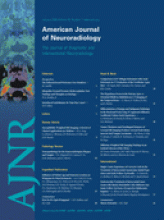Abstract
BACKGROUND AND PURPOSE: Selective venous sampling from the posterior portion of the cavernous sinus (CS) is recommended for the diagnosis of Cushing disease, because samples from the posterior portion yield higher adrenocorticotropic hormone (ACTH) levels than those from the anterior and middle portions. We prospectively assessed this intracavernous gradient of ACTH level to determine which site in the CS yields adequate sampling.
MATERIALS AND METHODS: In 5 patients with Cushing syndrome, cavernous sinography was performed to assess drainage pattern of the CS. Sampling was performed from the anterior, middle, and posterior parts of the CS, inferior petrosal sinus (IPS), and the peripheral vein. The ratio of the concentration in CS and IPS to that in peripheral blood plasma (C/P ratio) was calculated.
RESULTS: Cavernous sinography showed that the main drainage route was the IPS in 6 sides and that the pterygoid plexus (PP) was developed to the same extent as the IPS in 3 sides. In 1 patient, the CS drained mainly to the PP. In 1 patient with an ectopic lesion, no increase in ACTH level was detected. In 3 of 4 patients with Cushing disease, the highest C/P ratio was obtained from the posterior portion. In 1 patient whose main drainage route was the PP, the highest C/P ratio was obtained from the anterior portion. In this case, sampling data from the posterior portion and the IPS yielded false-negative results.
CONCLUSION: Understanding the drainage patterns of the CS is essential for interpretation of sampling data from the CS and avoiding false-negative results.
- Copyright © American Society of Neuroradiology












